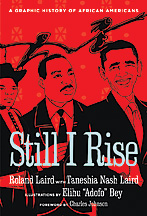Still I Rise: A Graphic History of African Americans by Roland Laird '82 with Taneshia Nash Laird. Illustrations by Elihu "Adofo" Bey, Foreword by Charles Johnson (Sterling).
The comics have not been kind to African Americans.
Until very recently it was rare for comic strips or comic books to portray black characters as real human beings. Instead, most comic artists mocked African American characters as jungle creatures, or condescended to them as superstitious figures from minstrelsy, or—when feeling kindly—painted them as good servants. In this context, Roland Laird's Still I Rise is a rarity: it's a book-length graphic telling of African American history, from colonial days through Barack Obama's inauguration.
The first edition of Still I Rise was published in 1997, at a time when comic sales were rapidly growing and critics were just beginning to recognize comic art as real art. In one sense, it follows Art Spiegelman's totemic Holocaust tale, Maus. In another, Still I Rise (the title comes from a poem by Maya Angelou) also follows Roots, the 1970s television miniseries sensation that was, at the time, the most-watched historical teledrama to date.
But Still I Rise stands on its own. Laird and his wife, Taneshia Nash Laird, have written a careful history of black popular life from the time of slavery onward, narrating that story sequentially, with sidebars on particularly famous or distinguished historical figures. At first glance, Elihu "Adofo" Bey's comic art seems somewhat schematic in style, but his tenacity, occasional rage, and outbursts of humor come through on the page. Text and drawings bring the reader ever closer to the artist's and writers' sensibility and sly gestures. They also highlight the authors' unwillingness to overplay their collective hand with didacticism—even in a saga filled with tragedy and violence.
In the book's foreward, comic artist Charles Johnson discusses the lack of comic artists in the black press; he does, however, mention George Herriman, who created Krazy Kat, and Ollie Harrington, who created Bootsie. He compares the making of Still I Rise to the making of a film, because so much of the narrative had to be written and rewritten, drawn and redrawn, to whittle it down to the most economical and entertaining expression.
In the end, Still I Rise stands with Ho Che Anderson's several-part graphic biography of Martin Luther King Jr. It recaps important chapters from black history in a medium that's true to our visual age and particularly likely to reach young people—and not only young African Americans.
The first edition of Still I Rise ended with the Million Man March, but this new edition has been updated to include Barack Obama's election to the presidency. While it would have made a perfect gift at any time, perhaps it means more now.
Paul Buhle, a senior lecturer in American civilization and history, writes comics and has edited ten comic art volumes, including The Beats: A Graphic History.





